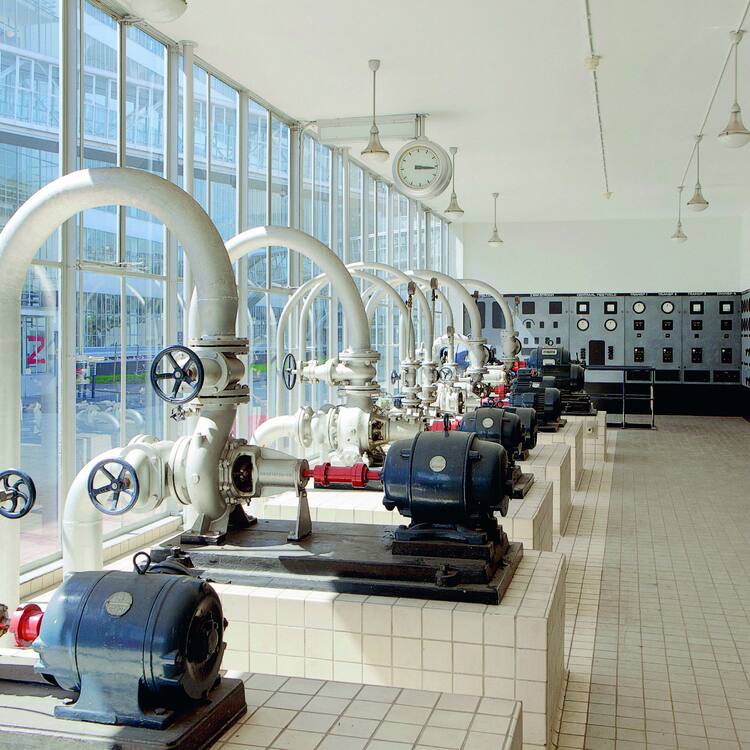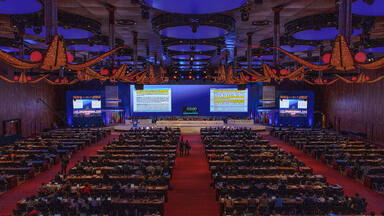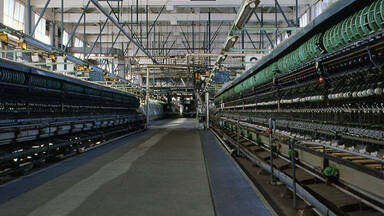Van Nellefabriek
Van Nellefabriek
Van Nellefabriek was designed and built in the 1920s on the banks of a canal in the Spaanse Polder industrial zone north-west of Rotterdam. The site is one of the icons of 20th-century industrial architecture, comprising a complex of factories, with façades consisting essentially of steel and glass, making large-scale use of the curtain wall principle. It was conceived as an ‘ideal factory’, open to the outside world, whose interior working spaces evolved according to need, and in which daylight was used to provide pleasant working conditions. It embodies the new kind of factory that became a symbol of the modernist and functionalist culture of the inter-war period and bears witness to the long commercial and industrial history of the Netherlands in the field of importation and processing of food products from tropical countries, and their industrial processing for marketing in Europe.
Description is available under license CC-BY-SA IGO 3.0
Usine Van Nelle
Réalisée au cours des années 1920 le long d’un canal de la zone industrielle du Spaanse polder, à Rotterdam, l’usine Van Nelle est un des fleurons de l’architecture industrielle du XXe siècle. Il s’agit d’un ensemble d’usines aux façades de verre et d’acier utilisant à grande échelle le principe du « mur-rideau ». Conçue comme une usine idéale, elle est ouverte sur l’extérieur et l’espace intérieur est évolutif en fonction des besoins. La lumière y est mise au service du confort au travail. Elle se veut une usine nouvelle, véritable symbole de la culture architecturale moderniste et fonctionnaliste de l’entre-deux-guerres. Elle témoigne aussi de la longue tradition portuaire et économique néerlandaise dans les domaines du conditionnement de produits agro-alimentaires importés (café, thé, tabac) et leur commercialisation en Europe.
Description is available under license CC-BY-SA IGO 3.0
Завод Неллефабрик
был спроектирован и построен в 20-х годах прощлого века на берегу канала в промышленной зоне Спаансе Польдер на северо-западе Роттердама. Неллефабрик – один из памятников промышленной архитектуры ХХ века. Он включает в себя комплекс зданий-цехов, фасады которых в основном выполнены из стали и стекла, демонстрируя широкое применение принципа прозрачной навесной стены. Завод задумывался как «идеальное предприятие», открытое внешнему миру: его внутренние служебные помещения изменялись в соответствии с необходимостью, а дневной свет использовался для обеспечения благоприятных условий работы. Неллефабрик представляет собой новый тип заводов, ставший выразителем модернизма и функционализма в культуре в период между двумя войнами. Он свидетельствует о долгой истории торговли и промышленности Нидерландов, в частности, отрасли, специализированной на импорте и переработке пищевых продуктов из тропических стран для последующей продажи в Европу.
source: UNESCO/CPE
Description is available under license CC-BY-SA IGO 3.0
Factoría Van Nelle (Países Bajos)
Diseñada y construida en el decenio de 1920, a orillas de un canal de la zona industrial del pólder de Spaanse situada al noroeste de Rotterdam, la factoría Van Nelle es una obra emblemática de la arquitectura industrial del siglo XX. Comprende un conjunto de talleres con fachadas de cristal y acero principalmente, construidas con arreglo al sistema arquitectónico del muro cortina. El edificio se concibió como una “fábrica ideal” abierta al mundo exterior, de tal forma que la luz del día penetrara en ella para proporcionar condiciones laborales agradables y que los espacios interiores pudieran adaptarse a la evolución de las necesidades de producción. Esta construcción encarna el nuevo tipo de fábrica que llegó a convertirse en un símbolo de la cultura modernista y funcional del periodo de entreguerras, y además constituye un testimonio de la larga historia mercantil e industrial de los Países Bajos en el ámbito de la importación de productos alimentarios procedentes de los países tropicales, de su elaboración industrial y de su comercialización en el continente europeo.
source: UNESCO/CPE
Description is available under license CC-BY-SA IGO 3.0
ファンネレ工場
source: NFUAJ
Van Nellefabriek
Source: unesco.nl
Outstanding Universal Value
Brief synthesis
Designed and built in the 1920s, the Van Nellefabriek demonstrates an extremely accomplished industrial architecture. It comprises a complex of buildings consisting of several factories aligned along the perspective of a large internal roadway, and close to several means of transport (canals, roads, railway lines). Supported on an internal structure of reinforced concrete, the facades of the main buildings consist essentially of steel and glass, making large-scale use of the curtain wall principle. Via a common purpose agreed between the entrepreneur and the project architects and engineers, the Van Nellefabriek embodies an ideal factory, open to the outside world, whose interior working spaces are progressive, and in which daylight is used to provide pleasant working conditions. It embodies the accomplished realisation of a new kind of factory that has become a symbol of the modernist and functionalist culture of the inter-war period. Lastly it bears witness to the long port-related economic tradition of the Netherlands, in the processing of imported food products (coffee, tea and tobacco) and their marketing in Europe.
Criterion (ii): The Van Nellefabriek brings together and makes use of technical and architectural ideas originating from various parts of Europe and North America in the early 20th century. It is exceptionally successful both in terms of its industrial setup and its degree of architectural and aesthetic accomplishment. It represents an exemplary contribution by the Netherlands to the Modernism of the inter-war years, and has since its construction become an emblematic example and an influential reference throughout the world.
Criterion (iv): In the context of industrial architecture in the first half of the 20th century, the Van Nellefabriek is an outstanding illustration of the values of relationships with the environment, the rational organisation of production flows, and dispatch via the nearby communication network, maximum admission of daylight to the internal spaces via the widespread use of a glass curtain wall with metal frames, and open interior spaces. It expresses the values of clarity, fluidity and the opening up of industry to the outside world.
Integrity
Throughout a long industrial history devoted to the same activity of industrial processing and packaging of food products, the various factories and their functional relationships with the logistical spaces (warehousing, dispatching, transport) have remained unchanged. The ensemble of buildings was preserved when the premises underwent an economic conversion in the late 1990s. The conditions of integrity in terms of composition (location and organisation of territory, functional relationships, panoramic views, etc.), and in architectural terms in its various aspects, have been met.
Authenticity
The restructuring and restoration of the property undertaken for economic reasons from 2000 to 2006 was carried out on a property which had been generally well maintained, and had never undergone reconstruction or conversion after its original construction at the end of the 1920s. The works have been carried out with great care, as part of a model project. The property’s authenticity has thus been appropriately preserved in each of its aspects, and this is clearly perceptible both to the visitors and to the new business users of the Van Nellefabriek.
Protection and Management requirements
The Van Nellefabriek enjoys the highest level of state protection as it has been a listed national monument since 1985. A large buffer zone has been established to ensure good visual expression of the property in an open environment. The overall protection of the whole ensemble will be guaranteed by the new Municipal urban development plan, whose drawing up is nearing completion, and by the inclusion of environmental preservation measures in the urban development plans for the five zones of its urban environment.
The property is managed by its current owner and operator, the private group Van Nelle Design Factory. The management of the conservation of the property’s architectural, urban and environmental values is based on the cooperation between the heritage departments of the City of Rotterdam and the Cultural Heritage Agency of the Netherlands. They jointly drew up the property’s management plan (January 2013) and their cooperation has been made permanent in the form of a Joint Management Committee which has been enlarged to include new experts. The property’s prime purpose is to accommodate economic activities in industrial, commercial and service fields. It is already open for visits, but this is seemingly not a major objective; frequency of visits could however increase over the coming years, giving rise to a need for specific facilities, which in turn must not be allowed to adversely affect the property’s integrity and authenticity.


